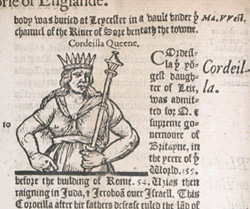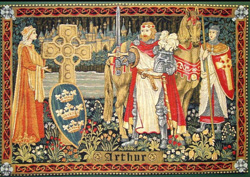
But imagine. Just for a second.
Imagine that for some reason our governmental infrastructure collapses. Even the military withdraws. Every city, town, county is left to its own devices.
What would happen?
I suspect that for a while things would rock along in some semblance of normality. But then that proverbial hand basket on its way to Hell would raise its head, er, handle. The semblance of order itself would disappear, and anarchy would probably reign for a while.
That’s the way it was in fifth century Britain, where I’ve set my new series of Arthurian mystery novels. And that’s as much of a curse as a blessing.

Under the Romans, jurisprudence was dispensed the Roman way, with judges and other magistrates. But they had no police force. Major offenses were handled by the province governor; minor offense by local officials. Theft was generally dealt with by the local centurion.Minor offenses were usually punished by flogging or beating and, perhaps, a fine. Major crimes were dealt with by execution using a wide variety of methods. And really heinous offenses, such as treason or refusing to accept the emperor’s authority, could mark you for crucifixion or being condemned to the gladiator arena.
Of course, when the Romans bailed out on Britain in 410, their laws hung on for a while. But by the time that Vortigern, the British leader, invited the Saxons over to help with the Pictish and Scotti (Irish) raids in the 440s, the country had reverted back to the tribes and lords/warlords ruled with a heavy hand. Evidence would indicate that newly developed Celtic laws tended to protect the poor and the weak and some scholars believe that the Church maintained the Roman laws, at least on the surface, but we really know little about such things in the fifth and sixth centuries.

The monk Gildas the Wise wrote a screed called On the Ruin and Conquest of Britain. It is, essentially, a religious work bemoaning the state of Britain. While some researchers claim that Gildas belongs to the generation after Arthur, others claim that Arthur killed Gildas’s brother Huaill. Unfortunately, it’s not really possible to pin down too many exact dates during this time period. What Gildas does do, however, is give us a couple of sentences about the state of law and order in the Britain of his time. He says that Britain had “judges, but unrighteous ones.” He also mentions that the judges do more to protect thieves and murderers than to “seek the rule of right judgment.” Jails were apparently in use as Gildas claims that those in jail are there because of political offenses, not true offenses. There were kings, but they were tyrants.
Murder was only murder depending upon who was killed and who did the killing. Crossing the local lord pretty much put you at his mercy. The Welsh chronicles tell us that killing a lord’s soldier was the same as attacking the lord himself. Again, whether theft and rape were crimes depended on who was the accuser and who was the accused. Justice was quick and cruel. Assassination, often between brothers or even father and sons, was an everyday hazard. Gangs of bandits, called latrunculii, infested the roads and forests. By nearly every conceivable definition of the word, there was no real law enforcement. With “capital” offenses, when the warlord chose to act, beheadings were the general method of execution, although hanging and flinging the suspect from a cliff were coming into style. The Saxons were particularly fond of hanging, though in the later part of the Dark Ages, after the Saxons were Christianized, they tended to favor amputation and beating rather than execution. There was a quid pro quo in Saxon England as well. Murders could spark blood feuds, where the aggrieved party could legally exact revenge. Druids, who are thought to have experienced a resurgence after the Romans left, allegedly favored multiple methods of execution.

Two laws, however, appear to have been inviolate. Tribal laws on hospitality were strictly adhered to, as well as the law of sanctuary. Otherwise, justice was a fleeting concept. The one exception to this seems to have been a late fifth-century king, Riothamus. A letter survives from a Gallic bishop named Sidonius to Riothamus which describes the king as renowned for his fairness and sense of equity. Some believe that Riothamus was the original Arthur.
If you’re looking for a more recent comparison, think about the Old West, when cattle barons functioned much as warlords or cartels controlled vast areas–as in the infamous Lincoln County War that spawned Billy the Kid. Justice and injustice often became confused, and punishments were either brutal and deadly or nonexistent.
For myself, I much prefer to live in the era wherein our present concept of crime and punishment reigns. But the Dark Ages are far more fun to write about. And bloodier.
When Tony Hays isn’t traveling the world, teaching students, and adopting puppies, he takes time out to write the Arthurian Mystery series from Tor/Forge.

There is this book by a English historian that I came across while in Grad school. For the life of me I can’t recall the name now (probably for some deeper psychological reason that I am not willing to face) but it dealt with using the devil and demons as a valid legal deffense throughout England’s history. It was an interesting topic and I always wonder if it was the genisis of today’s “plea of insanity”.
Those general concepts play a role in my Arthurian mysteries. My protagonist has lost half his arm in battle as one of Arthur’s lieutenants. People, in that day and time, viewed people with such a handicap as cursed by God or the gods. And they tended to avoid those bearing curses.
I’ve been having troubles with a group of money owed, and I’m no longer sure what to do about it. It makes feel that I might want to work with a lawyer to look if I can file for financial ruin! They could be able to see what sort of financial ruin could work excellent for me.
I’ve been having troubles with a group of money owed, and I’m no longer sure what to do about it. It makes feel that I might want to work with a lawyer to look if I can file for financial ruin! They could be able to see what sort of financial ruin could work excellent for me.